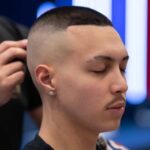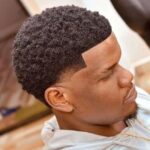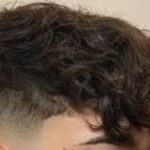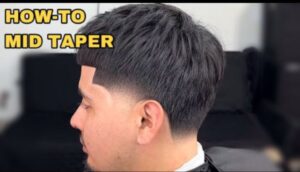So whether you like your cut more sophisticated or hair taper edgy and fashion-forward, a taper gives an otherwise basic hairdo a smooth and gradual transition. In this guide, we’ll go over the different types of tapers, how to get the taper you want, and how to maintain it.
What Is A Hair Taper?
Hair taper is the gradual decrease of hair length from long on top to short around the neckline and/or sides. A taper, on the other hand, is a subtle haircut that combines seamlessly in length, unlike a fade, which fades into hair that’s extremely short or even skin-level hair at the bottom. The taper gives a polished, clean aesthetic that suits multiple hair types and styles.
Types Of Hair Taper
Classic Taper
The classic taper—a no-fuss, subtle yet stylish hair taper is when hair grows shorter as it nears the ear, typically up to about an inch of the ear. It’s perfect for people who want a polished and refined look without being too over-the-top.
Low Taper
In a low hair taper, the fade begins above the ears for a clean but subtle transition. It works well short, medium, or long on top, making it a versatile choice for many.
Mid Taper
A mid taper starts higher on the sides than a hair taper, usually at the temples. It provides a more obvious gradient and works well with pompadours, quiffs, and other big hair styles.
High Taper
A high taper begins fairly high on the head, so there is a bold contrast between the longer hair on top and the closely cropped sides. It’s a daring look, and usually done by those who favor edgier styles.
Skin Taper
A skin hair taper the hair down to the skin for the crispest, cleanest finish. It’s an excellent choice for anyone seeking a sleek and modern look.
Temple Taper
Temple taper: To make only finer adjustments to the hairline near the temples. It is tapered in this manner in curly as well as textured haircuts, which helps give a clean finish to natural curls.
Burst Taper
A burst taper creates a circular fade around the ears; a taper on the back of the hair remains long. It’s now a fashionable kinda-sorta alternative regularly worn with mohawks or tousled hair.
A Guide To The Best Hair Taper
Choose the Right Tools
Clippers with multiple guards
A premium trimmer for detailed work
A comb for precision
scissors for mixing longer sections
Determine the Taper Length
Decide how smooth or steep you want the taper to be. A slow transition gives a more subtle effect, while a sharp mix gives a bigger look.
Start with Clean, Dry Hair
It’s better to wash and dry your hair beforehand, as this will help to give an even cut. Wet hair taper can also be longer than dry hair, resulting in uneven outcomes.
Use Clippers for the Base
Start at a higher guard setting and decrease.
Blend the hair in a scooping motion gradually.
Detail the Edges
Trim hairline, neckline, and sideburns with a trimmer.
Follow balanced, even placement on both sides.
Blend the Top Section
If needed, blend the longer top hair taper right into the tapered sides with scissors for a seamless transition.
Finish with Styling
Depending on the style desired, apply any hair taper products, such as pomade, gel, or wax, to achieve the final look.
Maintaining Your Hair Taper
Here are some tips to maintain your taper haircut and keep it looking sharp:
Regular Trims
A taper grows out on its own; however, scheduling a trim every 2-4 weeks helps to keep the taper sharp and in shape.
Use the Right Hair Products
Light pants for that classic style
Matte wax for a more textured effect
Curly hair taper moisturizers for preserving softness
Wash and Condition Regularly
Regular washing of hair keeps your scalp healthy and prevents product build-up due to dirt or excess oil.
Protect Your Hairline
Don’t Over-Trim: Don’t use clippers on the hair taper edges too much, as these are often prone to irritation and receding hairlines.
Brush and Comb Daily
Brushing or combing helps spread natural oils, keeping the hair neat and preventing mats and flyaways.
HAIR TAPER FOR A FACE SHAPE
Oval Face
Tapered face types go well with oval hair taper faces, despite this being one of the most common body types that lead well with tapered face types.
Round Face
A high taper creates more height, giving the face a more structured look.
Square Face
A mid or low taper is the best hair taper suited to soften sharp jawlines and create a more balanced look.
Heart-Shaped Face
A temple taper can sharpen the jaw while keeping the top hair fuller.
Diamond Face
A skin taper reduces the size of the cheekbones and has a more proportional appearance.
Conclusion
A hair taper is a trendy, adaptable hairstyle that suits a wide range of hair types and face shapes. However, if you prefer classic, low-maintenance hairstyles or bold, edgy hairdos, the right taper can take your hairstyle to the next level without you putting in much effort. As long as you keep up on maintenance and get regular trims, your taper will always look clean and crisp. There’s a lot of room for hair taper experimentation with this taper, so play around and find the taper that works for you!













